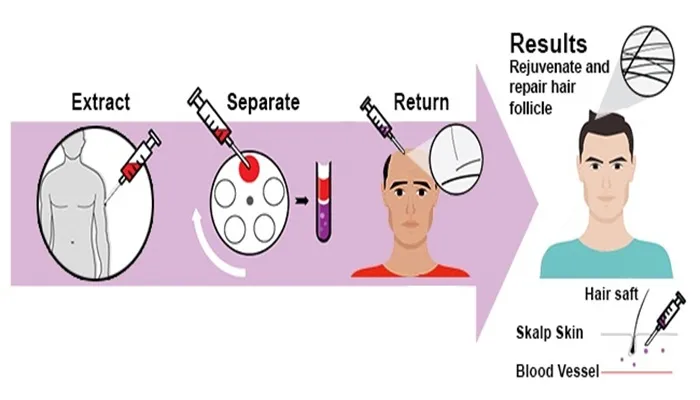Hair loss is a common concern for many individuals, affecting self-esteem and overall well-being. Platelet-Rich Plasma (PRP) therapy has emerged as a promising non-surgical solution for promoting hair regrowth. This article will explore the science behind PRP, its benefits, and the evidence supporting its use in hair restorations.
Understanding PRP Therapy
PRP is a concentrated form of platelets in plasma, the liquid component of blood. Platelets are small, colorless cell fragments that play a crucial role in the body’s natural healing process. When an injury occurs, platelets are activated and release a variety of growth factors, which are proteins that stimulate cell growth, proliferation, and tissue repair. In PRP therapy, a small amount of the patient’s own blood is drawn, typically from the arm. The blood is then processed in a centrifuge, a machine that spins the blood at high speeds. This process separates the blood into its different components: red blood cells, white blood cells, platelets, and plasma. The platelets and a small amount of plasma are then collected, creating PRP. The concentration of platelets in PRP can be up to 5 – 10 times higher than in normal blood.
The Science Behind PRP and Hair Growth
Hair growth occurs in cycles, including the anagen (growth) phase, catagen (transition) phase, and telogen (resting) phase. Hair thinning occurs when hair follicles shrink, leading to shorter growth cycles and thinner strands. PRP therapy helps by prolonging the anagen phase, increasing hair thickness, and awakening dormant follicles.
The growth factors in PRP, such as platelet-derived growth factor (PDGF), transforming growth factor (TGF), and vascular endothelial growth factor (VEGF).
- Increasing blood supply to hair follicles.
- Reducing inflammation that can cause hair loss.
- Strengthening hair roots.
- Encouraging the growth of new hair strands.
Clinical Evidence of PRP’s Effectiveness in Hair Regrowth
Research Studies
Numerous clinical studies have been conducted to evaluate the effectiveness of PRP in hair regrowth. These studies have generally shown positive results, although the extent of hair regrowth may vary depending on the study design, patient population, and treatment protocol.
Randomized Controlled Trials
Several randomized controlled trials have compared PRP treatment with placebo or other hair loss treatments. One such study found that patients who received PRP treatment experienced a significant increase in hair density and thickness compared to those who received a placebo. The study also reported an improvement in the overall appearance of the hair. Another randomized controlled trial compared PRP with minoxidil, a commonly used topical treatment for hair loss. The results showed that PRP was more effective in promoting hair regrowth, especially in patients with androgenetic alopecia, the most common form of hair loss in both men and women.
Case Series and Observational Studies
In addition to randomized controlled trials, there have been many case series and observational studies that have reported positive outcomes with PRP treatment. These studies have shown that PRP can be effective in treating various types of hair loss, including androgenetic alopecia, alopecia areata, and telogen effluvium.
Real – Life Patient Experiences
In addition to clinical studies, real – life patient experiences can provide valuable insights into the effectiveness of PRP in hair regrowth. Many patients who have undergone PRP treatment report significant improvements in the appearance of their hair. They often notice an increase in hair density, thickness, and overall health. Some patients have reported that PRP treatment has helped them regain their confidence and self – esteem.
Benefits of PRP for Hair Regrowth
Natural and Safe Treatment: PRP uses the patient’s own blood, reducing the risk of allergic reactions or major side effects.
Minimally Invasive: PRP therapy is a non-surgical procedure with minimal downtime. Patients can typically resume normal activities immediately after treatment.
Improves Hair Thickness and Strength: PRP not only stimulates new hair growth but also strengthens existing hair strands, resulting in healthier and thicker hair.
Slows Down Hair Loss: Regular PRP sessions can reduce excessive shedding and maintain hair volume.
Quick Procedure: A PRP session typically takes about 45–60 minutes, making it a convenient option for hair restoration.
Who Can Benefit from PRP Therapy?
PRP injections are ideal for individuals experiencing.
- Male or female pattern baldness
- Thinning hair
- Early hair loss
PRP is less effective for people with complete baldness or severe hair follicle damage. Consulting a hair specialist is crucial to determine if PRP is the right choice.
Conclusion
PRP therapy offers a natural, non-surgical solution for hair loss, with clinical evidence supporting its efficacy in promoting hair regrowth. The treatment harnesses the body’s natural healing properties to stimulate hair follicles, increase hair density, and improve overall scalp health. If you are considering PRP for hair restoration, consult with a qualified specialist to discuss your options and determine if this treatment is suitable for your specific needs.
Related topics:
- How Much Effective Is PRP for Hair Loss: What You Need To Know
- The Cost of PRP for Hair Loss: A Comprehensive Guide
- How Long Does Perimenopause Hair Loss Last?


